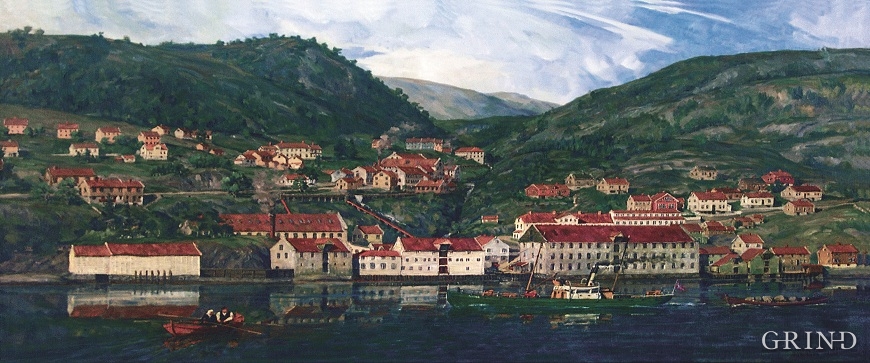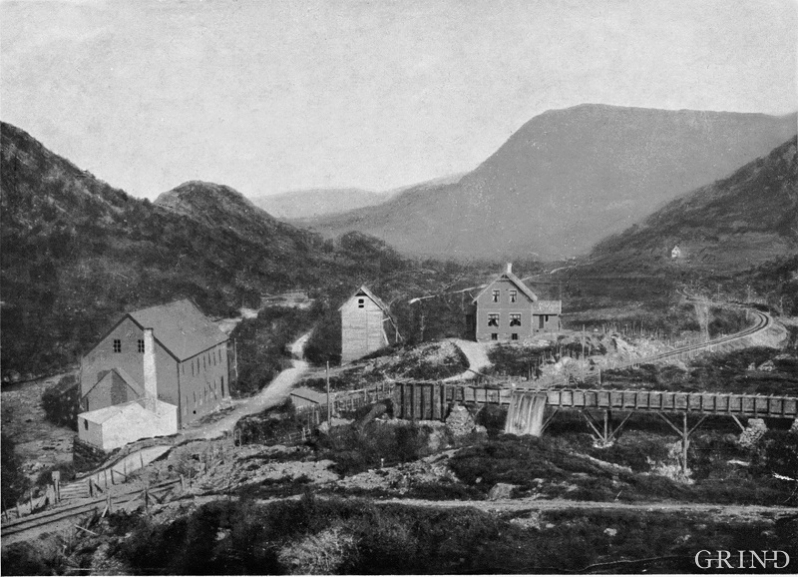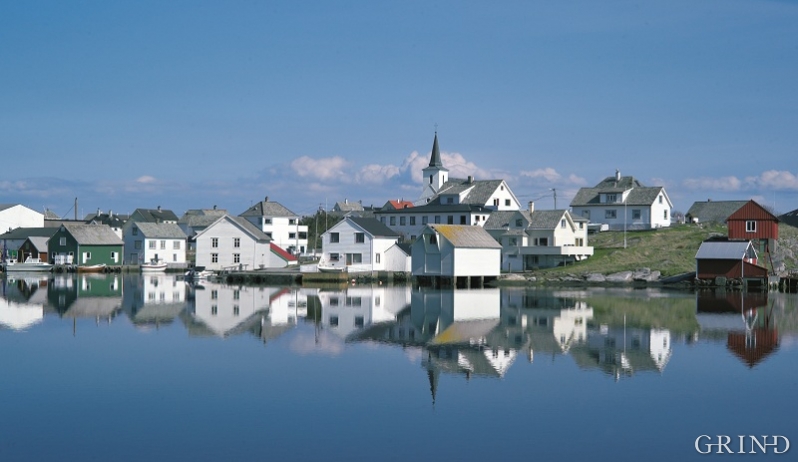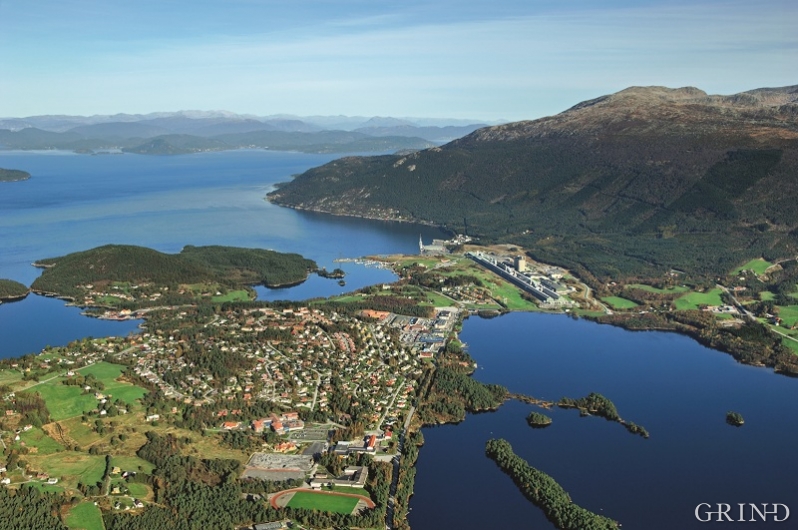Publisert: 19.05.2009 | Forfattar: Anders Haaland
The industrial settlement of Ytre Arna in the 1880s. A painting by Ole B.Eyde, 1936. (Egil Korsnes, owner: Høie-Arne a.s.).
A STORY OF TRADE, INDUSTRY AND COMMUNICATION
One Sunday in 1845 young Peder Jebsen from Slesvig took the walk along the post road from Bergen to the north across Borgaskaret. He had taken several such walks in the nearest villages around Bergen to look for a suitable waterfall. After three years work in a Bergen clothing company he had found that it was about time to start a textile factory. The British ban on the export of textile machinery had recently been lifted and Norwegian Customs charges on raw materials were low. From the path above Borgaskaret he came down to Indre Arna, but here the fall on the river was too small. He followed it to Arnavågan and went on out to Ytre Arna until he came upon the Blindheim river. He bought it on the spot.
In this way Sigmund Grieg gives us a thumbnail sketch of the tradition behind industrial magnate Jebsen who gave the push to the development of the first urban settlement (in its modern meaning) outside Bergen. The development of urban settlements after 1850 is a historic process of great significance for the cultural landscape. Besides the great land reforms and the new ways of working in agriculture, the changes in the settlement pattern and the building of a road network with roads, bridges and cuttings were the single factors which have most significantly contributed to the metamorphosis of the county’s physical visage in the last 150 years. The forces which have driven this process forward are thus cultural factors of great importance.
From dispersed to dense settlements
The 115,000 people who lived in Hordaland in 1845 harvested a greater share of the land area and the marine resources than the 400,000 who live there today. But interaction with nature in those days took gentler forms. The motive force was hand power, horses, wind and water. Fossil fuels, electricity and artificial fertilisers were unknown; Nature’s own cycle dominated. The houses were small and the building materials were Nature’s own. Apart from a couple of paddle steamers which now and then ploughed up the coast to and from Bergen, there was nary a machine nor a motor to break the silence, and there was hardly a factory or transport facility. Even the maritime city of Bergen lacked proper quays!
Only a fifth of the population were to be found in the county’s only urban settlement, Bergen. An urban settlement is defined by the geographers as a gathering of houses with more than 200 residents, where the houses are situated no more than 50 meters from each other and where at least three quarters of the population are employed in businesses other than agriculture or forestry. The concept does not distinguish between population concentrations with or without formal town status.
In 1845 there were indeed gatherings of houses outside Bergen where the inhabitants worked with handicrafts, milling, processing of herring, trade or guesthouses. But none of them exceeded 200 persons, hardly 50 inhabitants - with a possible exception of Alvøen. Even the town itself was small, densely built up with folk living in close quarters. The 20,000 Bergen folk huddled together between Rothaugen on Sandviken and St.Jørgen at the Stadsporten. A couple of thousand suburban dwellers were spread out between Sandviken, Møhlenpris and Nygaard where a rural idyll otherwise reigned.
Today Bergen is spread out over a large part of the Bergen Peninsula. The urban society of Bergen, together with areas dependent on the city like Askøy, Fjell and Os, encompasses over 60% of the county’s inhabitants. Almost 70 urban other settlements bring the proportion who live in urban areas up to 70%.
From a developing to a developed country
What forces have brought about this development? The changes in the settlement pattern reflect an equally strong change in business and trade. The enormous economic growth since 1845 has taken place in parallel with the transfer of the work force from primary to secondary and tertiary industry. Whilst the first provided a living to between 70% and 80% of the population, that share has today fallen well below 10%.
In agriculture, forestry and fisheries, Nature is broadly exploited, literally speaking. The factories on the other hand are compact workplaces with the employees gathered together in one or a few buildings. They constitute the physical framework around a centralised source of power; the water turbine or the steam engine, with relevant work machines. Handicraft workshops, businesses, banks, hotels, schools and public offices thrived best together with other workplaces of a similar type. They assumed a certain population base on the spot or in the hinterland. With long working days with only Sunday off and no car or bus for the residents, the houses had to be within walking distance of the workplace. In agriculture there was always a conjunction of home and workplace.
The switch from dispersed to dense settlement is the construction-wise expression for the change from area extensive to concentrated business. In this way the urban settlements grew up.
The urban settlements
The urban settlements are classified by their economic function. When the principal activity is service provision for a hinterland, this is called a “central place”. In the “communications urban settlement” the most important work places concerned with transport facilities of various types. It can be a railway (station town) or a ship (beach place, shipping harbour). In the “industry or factory place” it is industrial production which is the main concern. Where one single trade is dominant the expression “the one trade town” is used. And “fisheries places” are also relevant in Hordaland.
In the old farming society a big textile factory represented a completely new and purely capitalistic form of business. But it was not necessarily an expression of modernisation of traditional business. It could be so as when wool spinning mills worked on a leasing basis for the district’s farmers. The same was true of village mills and sawmills. But most commonly the new factories came to the countryside in addition to local business and they were “foreign bodies” placed there by others and for special reasons. The emergence of a central place thus tells of a traditional society on its way to a greater degree of specialisation and adjustment to the market, indeed, “capitalisation”. This went hand in hand with the development of new roads: steamship routes, post and telegraph services.
The decade from 1845 to 1855 marks a divide both in the Norwegian and the local modernisation processes. 1845 was the last year when Bergen was recorded as the only urban settlement in Hordaland County.
In 1855 a new one has arrived, Ytre Arna, around Peter Jebsen’s cotton factory in the open country at Blindheimselva. In the same decade the country got another textile factory, a mechanical workshop, BMV, and the country’s first private company for regular steamship traffic, the Bergen Steamship Company.
The growth of the urban settlements in Hordaland - how many, what type, when and where they came - provides important information on the modernisation process here in the west. Since the factors forming urban settlements became apparent in varying strengths at different times, the history of them can be divided into three phases as follows:
1. 1850-1920: “The factory places’ classical epoch”
2. 1920-1950/60: “New communications, electrification and small industry in the rural areas”
3. 1950/60-1990: “The epoch of the private car, public sector transfers and the detached house”
The factory locations
Industry as an urbanisation factor dominated the first period. Of the 25 urban settlements which grew up between 1845 and 1920 no less than 18 of them were factory places: most of them dependent on one single industry. The factory places can again be divided into three categories.
The oldest were built up around factories which used running water as their direct motive power. Bergen’s large population and its commercial hinterland constituted a favourable market for consumer goods, especially textiles and flour. The “entrepreneurs” who wanted to exploit this market , had to get out of the city with their factories. Bergen, despite its wealth of precipitation, was poorly equipped by Nature with hydropower. Because of the danger of fire, there had been a ban on the use of steam engines within the city limits.
Textile factories and flour-milling
The cotton factory in Ytre Arna was followed by a hemp spinning mill at Fana Hammeren in the same year. A wool product factory was founded in Ytre Arna in 1853. These pioneering companies brought along in their wake a series of other textile factories, situated where large enough waterfalls met the sea or crossed the railway line. Salhus got its first two factories in 1859 and 1896, Dale in 1878, HOP in Bergen in 1879, Tysse in Samnaker in 1886 and Eidsvåg in 1896. In all these places the factories gave rise to new urban settlements, some small, some bigger. Ytre Arna had almost 1,000 inhabitants by 1875. Textile factories were also built in Trengereid in 1895, in Espeland in 1896 and in Strusshamn on Askøy in 1910, although here the population did not pass the limit for an urban settlement until after 1920.
The mill at Vaksdal also created an urban settlement, whilst Bjørsvik on Osterfjorden was too small. A third type of hydropower based industry was the old paper mill at Alvøen. The limit of 200 was reached in 1890 whilst the branch factory for cardboard at Sævareid in Fusa never reached it.
All these factories can be regarded as part of the Bergen industrial environment. They were linked up to the town’s market and its expansive trading companies. The capital came from Bergen, and the offices naturally were in the same town. The factories were built in sparsely settled or inhabited areas, and the consequences for the local business were modest. The new businesses created a ring around the city, with a working population who, under other natural conditions and other power technologies would have ended up in the city itself. The Aker River in Kristiania (Oslo) brought together most of the businesses of the same type inside the city boundaries there.
Heavy industry
The other group of factory locations have to do with the exploitation of hydropower to serve the electrical and chemical industries; the same development which gave rise to the new industrial ventures at Rjukan and Notodden, and which generated the heated debates on the water licensing laws. After the turn of the century large electrochemical and electrometallurgical companies were started in three locations on the steep slopes of the Hardanger Fjord at TYSSEDAL (1906/12) at Odda (1908/10) and in Ålvik (1914/18). These factories need much larger amounts of power than the textile factories and mills. They were sited close to the sources of power at Odda and Tyssedal before the transfer of electrical power became economic. Tyssedal and Ålvik had small populations before industrialisation whilst Odda had been a small urban settlement before 1890 based on tourism. All three had good access for large ships.
If the textile factories and the mills had few links with the original local business, this was even more true for these new businesses. They cannot even be regarded as part of the Bergen industrial environment since both Norwegian and international capital were already heavily involved here. On the other hand Odda, by virtue of its three major industrial workplaces, came to develop itself into an urban society in all but name. In 1920 the population was 4,000 and 6,600 in 1950.
Rock and sardines
Apart from the hydropower based factory locations, four small urban settlements grew up around raw-material oriented industry. Litlabø in Stord was a mining community; Stordø pyrite mines were opened in 1907 and supplied, as did the Hardanger businesses, raw materials for major European industry. The three others were linked to the domestic fisheries industry through sardine factories and related business, that is Follese and Hetlevik on Askøy and Sunde in Kvinnherad.
The three small fishing communities, Tælavåg and Solsvik on Sotra and Espevær in Bømlo had a few industrial and commercial functions. The same went for Jondalsøyri which was a settlement on the beach based on ferry traffic and building wooden boats.
The central places
The only central places were Leirvik in Stord (1875), Voss (1890), Nesttun (1890) and Osøyri (1920). These combined commercial service functions for a rich agricultural hinterland with being transport hubs. But industry soon came to play an important role here too: Leirvik was classified in 1950 as an industrial settlement and Osøyri as an industrial/commercial settlement.
The growth of only four central places in as large a county as Hordaland over a period of 70 years is little. The less populous county of Rogaland had 6 small coastal towns in 1875 as well as several central places. Does this mean that Hordaland had fallen behind in the modernisation process? A consideration of the pattern of settlement in Hordaland raises the same question “on a lower level”. Apart from two small “sardine settlements” on Askøy there was not a single urban settlement in the whole populous North Hordaland as recently as 1920. This had been regarded as a less prosperous district than Voss, Hardanger and Sunnhordland. The pattern is the same if we look at the dates of establishment and the extent of coverage of the savings banks: North Hordaland is behind here also. It is however probable that the answer lies elsewhere. North and Central Hordaland were such a short way from Bergen that the need for their “own” central places was less here. The big city cast a shadow not only over the nearby villages, but also to a certain extent, over the more distant ones far into the neighbouring county of Sogn og Fjordane.
Furniture and engines
Between 1920 and 1950 17 new urban settlements emerged. Three were “delayed” versions of the classical textile settlements established with Bergen capital. Trengereid, Espeland and Strusshamn. The remainder consisted of eight industrial settlements, four central settlements and two in the category of “other”. These industrial settlements were an other type than the old ones. They were an expression of the “independent” economic growth in the villages. The economic crisis of between the Wars hit traditional urban industry and heavy industry particularly hard. Lower income levels. Municipal power plants and cheap electrical engines opened up new possibilities for enterprising rural people, especially in businesses geared to the domestic market and with roots in traditional village crafts industry; furniture and wooden goods, clothing and small mechanical workshops.
Wooden goods and furniture became important businesses in Indre Arna, Øystese, Breistein and Haukeland: They also become significant for Osøyro and the neighbouring community of Søfteland and for areas along the Oster Fjord without the urban settlements becoming large enough to become statistically “visible”. The iron and metal industries created urban settlements such as Rubbestadneset in Bømlo and Lonevåg on Osterøy, as well as a smaller settlement like Hosanger. At Breistein and Lonevåg another small village business, tanning, had contributed to the development. Tanning was also quite healthy in Valestrandfossen, Isdalstø and Alversund.
Speeded up road construction and new buses created much better overland communications for the rural areas. This was a major factor behind the growth of settlements such as Norheimsund, Eidfjord, Etnesjøen and Ølensjøen. All these settlements were situated far from Bergen and in the south of the county. Skåneviksjøen and Førde in Sunnhordland were classified as “other” settlements. These too must have had a sizeable amount of central functions.
The period was an interlude. Even if some of the older urban settlements continued to grow, less happened than in the previous and forthcoming periods. Only one of the 17 new settlements, that is Norheimsund managed to reach a population of 500 in 1950. The period is distinguished more by evolution rather than by “revolution”. The growth of rural-based small industry was an expression of the tendency towards decentralisation and democratisation in the important business of industry.
Cars, houses and the town hall
Up until the 1950s the development of urban settlements in Hordaland developed on conventional lines. Even although buses, trucks and cars gathered an increasing significance in parts of the county after 1930, the layout of the urban settlements was still characterised by the fact that the houses lay within walking distance of the workplaces; the house groupings were compact. A rapid increase in private car ownership during the 1960s came to change all this, at first cautiously and then radically. The car made possible a completely new pattern of dispersed settlement, both within the housing areas themselves and as regards their location in relation to workplaces. Together with a number of new ferry connections, bridges and express ferry services it also made possible daily commuting over large distances. The same welfare development also gave room for the construction of detached houses with gardens for an increasing number of workers - yet another contribution to the “thinning out” of the urban settlements.
The pattern of urban settlement was also influenced by structural changes in industry: Many of the factories in the county’s older industrial settlements were in stagnant or threatened sectors; textiles, milling and the sardine industry. Here growth stagnated or the population fell. Today most of these businesses are gone. This was also true for the furniture industry. The smelting industry has undertaken extensive rationalisation of its production. The lack of integration into the hinterland gave few opportunities for readjustment.
On the other hand since the 1960s some new major industrial facilities associated with aluminium processing, construction of tankers and the needs of the oil business, have developed, that is the plants at Husnes, Leirvik, Mongstad and Stura. These have created entirely new concentrations of population and breathed life into the old ones.
A considerable expansion of the public administration, schooling and other public services, partly financed by transfers of funds from other better off municipalities and central Government has also had a bearing on the pattern of settlements. In 1980 only 8 of the 34 municipalities in Hordaland County lacked an urban settlement of one kind or another, whereas about half of the 55 municipalities in 1950 lacked such a centre. The central places’ share of the new urban settlements has increased greatly and this is evident from the many new municipal centres with imposing town halls and large central schools.
The number of settlements grew from about 40 in 1950 to almost 70 in 1980, despite the fact that a number of older settlements, close to the city had been swallowed up by Bergen. Despite the loss of many, old central functions during this period, Greater Bergen has in fact grown far beyond its borders. It expanded from “the city between the hills to the city around the seven hills” - a geographical extent which, in continental terms, is worthy of a city of a million people.
When urbanisation in the epoch of the private car and the detached house has been able to take up so much area, a major reason has been the low alternative use value. This is due both to the weak position of the district’s agriculture and especially because of the extensive areas of outlying fields of low productivity. What European cities can boast of big areas of hill in their centres? Even in those areas where Nature has not imposed a dispersed pattern of settlement, the planners have been able to permit low-density development: The new housing areas are no longer situated as wide belts extending from the older urban developments, but are now completely separated by open spaces and agricultural land.
This development has opened up for a new definition of the concept of urban settlement. We now have to draw on concepts like “a commuter region” or an “urban region” or “concealed” and “dispersed urbanisation”; “new developments where people work in the city, but where development is too small or spread to be termed a settlement or a suburb”. The boundaries between the city and “not the city” are in the process of being wiped out.
- Hansen, J. C. (1965-1966) Industriell utvikling og tettstedsvekst: norske eksempler. Norsk geografisk tidsskrift, 20(6-7).
- Hansen, J. C. og Holt-Jensen, A. (1982) Ressursene våre. Det Moderne Norge, nr. 1. Oslo, Gyldendal.
- Myhre, J. E. (1977) Urbaniseringsprosessen i Norge i industrialiseringens første fase ca. 1850-1914. I: Blom, G. A. red. Urbaniseringsprosessen i Norden: det XVII. nordiske historikermøte, Trondheim 1977, bind 3. Oslo, Universitetsforlaget.
- Myhre, J. E. (1983) Urbaniseringen i Norge etter første verdenskrig. I: Jokipii, M. & Nummela, I. (1983) Föredrag vid det XVIII Nordiska historikermötet, Jyväskylä 1981. Jyväskylä, Jyväskylän yliopisto.
- Myklebost, H. (1957) Tettbygga i Hordaland og Sogn og Fjordane. I: Vestlandet - natur - busetnad - næringsliv: festskrift til Vestlandske Bondestemna 1932-1957. S. 69-84.
- Myklebost, H. (1960) Norges tettbygde steder 1875-1950. Ad novas, nr. 4. Oslo, Universitetsforlaget.











